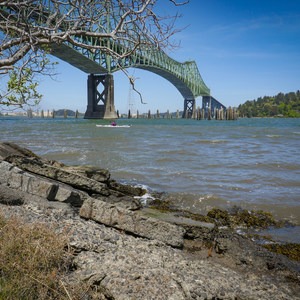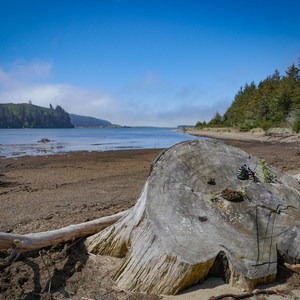Although clamming is a pastime throughout the beaches and estuaries of the Pacific Northwest, Waldport's Alsea Bay is unique within Oregon because it's the only estuary in which, by law, the tide does not have to be negative in order to clam.
Here, at low tide, recreationalists and subsistence clammers come out to get their bounty of the most common bay clams, including gaper clams (Tresus capax), soft-shell clams (Mya arenaria, non-native from New England), purple varnish clams (Nuttallia obscurata, non-native from Japan), and heart cockle clams (Clinocardium nutallii). The largest clams will be found in the deepest water channels, and gapers are more obscure and will only be found west of the bridge, while purple varnish (and ghost shrimp) will be found in near-endless quantities outside the channels.
If crabbing is what you're looking for, head east to the Alsea Bay Marina, where abundant dungeness crab (Metacarcinus magister) call these deeper waters home.
Note: The Oregon Department of Fish and Wildlife also has specific locations within Alsea Bay in which clamming is permitted. See a map here.
Rules, Regulations and Licenses
A shellfish license is required for anyone over 12 years old. Before heading out, be sure to call the Shellfish Hotline at 1.800.448.2474 to confirm seasonal closures, or visit the State of Oregon's Shellfish Biotoxin Closure page.
- Dungeness crab: Daily limit of 12 male crabs (it is prohibited to catch and keep females), minimum size 5 3/4 inches. Crabbing is open in estuaries (i.e. bays), beaches, tide pools, piers, and jetties year round. Crabbing in the ocean is CLOSED for Dungeness crab from October 16 to November 30.
- Red rock crabs: Daily limit of 24, any size or sex.
- Razor clams: Daily limit of 15.
- Bay clams (gaper, butter, littleneck, cockle, and geoduck): Daily limit of 20 (only 12 of which can be gaper clams). No more than one daily limit per day may be taken per person. No more than two daily limits may be in possession. If unbroken, butter (Saxidomus giganteus), cockle (Clinocardium nuttallii), or little-neck (Protothaca staminea) clams may be returned only in immediate digging area. All other clams must be retained regardless of size or condition.
- Softshell and piddocks clams: Daily limit of 36.
- Purple varnish clams: Daily limit of 72.
- Shrimp and prawns: Daily limit of 20 pounds including the shell.
- Mud and ghost shrimp: No limit.
- Mussels: Daily limit of 72.
- Sand crabs, mole crabs, kelp worms and sand worms: No limit.
Call the Oregon Department of Fish and Wildlife at 1.800.448.2474 for more information.
Logistics + Planning
Current Weather: Powered by Dark Sky







Congestion
Parking Pass
Pros
Cons
Features
A profound concept originally envisioned by governor Oswald West, in 1967 the Oregon legislature ultimately realized his vision of making the entire Oregon Coast forever open to the public in a piece of landmark legislation titled the Oregon Beach Bill, officially making all 363 miles public land. "The People's Coast" is truly a one-of-a-kind coastline, a unique blend of mountains and rocky stacks, towering old growth forests, marine sanctuaries, tide pools and kelp forests, charming towns, historic fishing communities, world-class golfing, breweries, and simply jaw-dropping scenic beaches. We encourage you to plan your next trip at visittheoregoncoast.com or by calling (541) 574-2679.


















Comments
Sign In and share them.